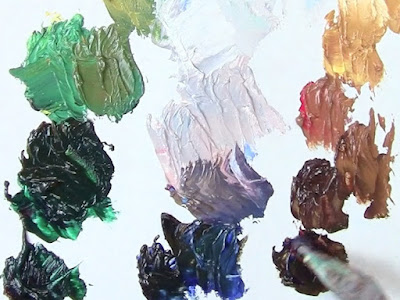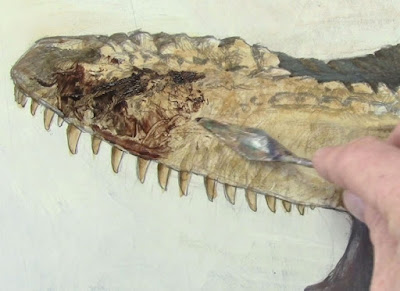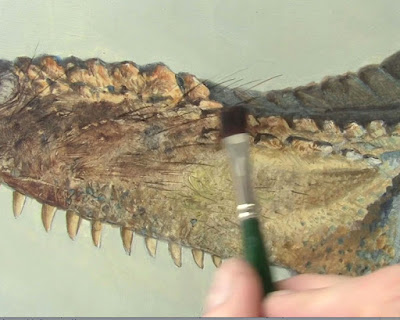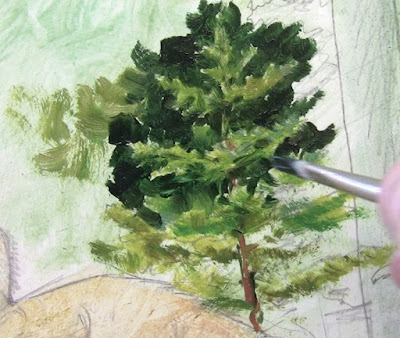Thanks, Sean, and those are good questions. Here are ten tips.

1. Mix plenty of paint
If you prepare plenty of paint on the palette, you're more likely to use it. Sometimes a big, juicy stroke full of paint is what you need for a passage. With oil, do this mixing with the palette knife before the painting session. You'll save yourself a huge amount of time, and it will triple your painting speed. Here I'm loosely mixing value strings of green, gray-violet, and orange.
2. Use it thinly, too
Although thick, generous paint is attractive, also be ready to use the paint thinly and delicately. Have a tiny brush for extremely delicate details. Have a soft blender to blur out some areas. Rarely should a painting be covered equally with thick paint strokes. Variety of handling is almost always desirable.
3. Variety of brushes
Use a lot of different brushes: big ones, small ones, synthetics, natural fibers, stiff ones, soft ones, flats, filberts, new brushes, and old splayed out brushes. Experiment with them all and get to know what you can do with them. With old brushes you can push and pound with them (moving the brush in the direction of the brush tip) as well as the typical movement of gently stroking away from the tip.
4. Big brushes
Before you start painting, select a family of brushes that you expect will do the job. Five or six will often be enough for a given painting. They should range from large to small. But for any given passage, choose the biggest brush you can get away with for that passage.

5. Don't forget the painting knife
The painting knife is useful not just for mixing paint, but also for applying it. Use it for troweling on paint and for dropping in random textures. Here I'm dragging dark paint over a dry underpainting, so I can pull it over the bumpy underpainting. I can get textures this way that I could never get by diligently painting stroke by stroke.
6. Scratch through
Don't forget that you can scratch through the wet paint with the tip of your brush handle. This works with wet oil paint. Scratching through is a good way to sign an alla prima painting. (An alla prima painting is executed from start to finish all in one session.)

7. Use the edges and corners
Flat brushes are really three or four brushes in one. The knifelike edge can give you thin lines or hairs, and you can use the corners for details that are smaller than the width of the brush. Filberts were invented because they have advantages of both flats and rounds.
8. Make every stroke count
There's no formula for good technique, but most often it comes from a sense of urgency and economy. Use whichever touches convey the most information about your subject with the least effort. That doesn't mean you have to be hasty and loose, but rather that you think before you mix and apply paint. Great painters of the past have often been described as holding their brushes above the canvas deliberatively before going in for the stroke.

9. Better with practice
Yes, it gets better with practice. The best kind of practice is painting from living subjects in changing light, because the dynamics and risk adds more focus than you're going to get under controlled studio conditions.
The deliberate, thoughtful but efficient stroke-by-stroke consciousness becomes second nature as you focus more attention on the subject rather than on the surface features of your painting. Think how economical and automatic your movements are when you wash dishes or tie your shoes. That's the way you want your brushwork to be. Your brushwork should be deliberate and controlled, but occasionally wild and impetuous.
10. The test of good technique
As you paint, your ultimate goal is to think beyond the strokes, the way a race driver is thinks about the line they're taking on the turn, not about how they're holding the steering wheel. Try to think as much as you can about the thing you're painting and how its made and how the light is playing on it. If you can do that and reach for the brushes more unconsciously, you'll be more likely to make the brushstrokes less attention-getting.
So, what's the test of good technique? Ideally the viewer shouldn't notice it. Rather, their awareness should be directed to features of your picture that are on a higher level, like the light, mood, or story.
----
The images in this post are from my tutorial video Tyrannosaurs: Behind the Art, which demonstrates oil painting techniques and brushwork in the context of reconstructing extinct dinosaurs.
Follow me on Instagram







8 comments:
This was wonderful and much needed, thank you.
Thanks, this was very useful information
I really have to try pre-mixing paint, as you suggest (and have suggested elsewhere). I guess I naturally go to the mix-as-you go school, a la Norman Teeling in the previous post. Mixing on the fly feels more intuitive, but "intellectually" I can see having the mixtures in front of you is a real time-saver. I can imagine a sort of hybrid technique too - that is the pre-mixed piles gradually become the source of intermittent mixtures.
Tom, you got it. I usually pre-mix the main colors I'll be needing, and then free-mix if I need something outside the gamut that those colors give me. You can be loose with your premixing, and leave some warm and cool variations that you can use later. Here's an old post on pre-mixing if you missed it: http://gurneyjourney.blogspot.com/2008/02/from-mask-to-palette.html
i wish to learn painting and skills of Brushstrokes, but i get valuable ideas from this post.
Melbourne airport transfer
Mastering basic brush strokes are a pre-requisite before you embark on an artistic journey to the colorful world of paints. Here are 5 basic brush strokes you must learn to master your painting skills fast. Visit the link to know more about these 5 basic brush stroke techniques. https://www.showflipper.com/blog/5-Basic-Brush-Strokes-You-Must-Learn
Fantastic post. Technical directed tips without flab. Thanks.
excelent! thank you
Post a Comment